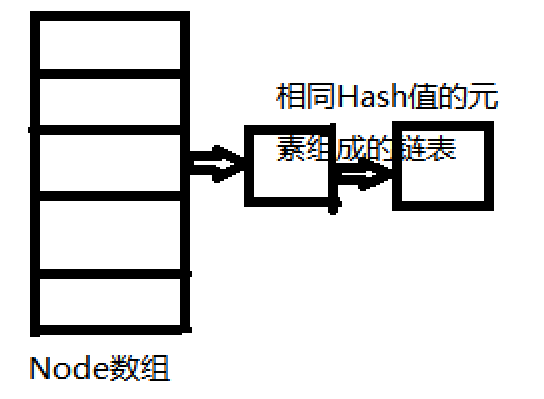HashSet&HashMap浅析
HashSet特性
1、不能保证元素是有序的
Hashset内部采用hash值进行存储索引,而hash值不保证有序
2、不保存重复元素
由于HashSet底层是将要插入的元素当作map的key进行存储(底层采用HashMap作为数据存储结构),所以不保存相同的数据。
HashSet的构造方法
内部由HashMap支持,当没有指定参数的时候, loadFactor = 0.75 不初始化threshold
public HashSet() {
map = new HashMap<>();//由hashmap支持,内部存储是一个hashmap
}
使用Collection对象初始化HashSet时,threshold初始值为:max(c.size/0.75+1, 16)
javapublic HashSet(Collection<? extends E> c) {
map = new HashMap<>(Math.max((int) (c.size()/.75f) + 1, 16));
addAll(c);
}
可以自定义threshold和loadFactor的初始大小
public HashSet(int initialCapacity, float loadFactor) {
map = new HashMap<>(initialCapacity, loadFactor);
}
单独设置threshold的初始化大小
public HashSet(int initialCapacity) {
map = new HashMap<>(initialCapacity);
}
Jdk1.8会调用tableSizeFor来对initialCapacity进行处理。此方法计算出接近initialCapacity参数的2^n来作为初始化容量
public HashMap(int initialCapacity, float loadFactor) {
if (initialCapacity < 0)
throw new IllegalArgumentException("Illegal initial capacity: " +
initialCapacity);
if (initialCapacity > MAXIMUM_CAPACITY)
initialCapacity = MAXIMUM_CAPACITY;
if (loadFactor <= 0 || Float.isNaN(loadFactor))
throw new IllegalArgumentException("Illegal load factor: " +
loadFactor);
this.loadFactor = loadFactor;
this.threshold = tableSizeFor(initialCapacity);
}
static final int tableSizeFor(int cap) {
int n = cap - 1;
n |= n >>> 1;
n |= n >>> 2;
n |= n >>> 4;
n |= n >>> 8;
n |= n >>> 16;
return (n < 0) ? 1 : (n >= MAXIMUM_CAPACITY) ? MAXIMUM_CAPACITY : n + 1;
}
HashSet添加元素
public boolean add(E e) {
return map.put(e, PRESENT)==null;
}
把添加的元素作为内部维护存储数据的map的key
可以看出有个hash的属性,HashMap的底层就是一个Node数组,通过对key的hash值化,在根据这个i = (n - 1) & hash公式获得插入元素的应该存储位置。因此,由于这样的设计,使得HashMap的元素获取为O(1)复杂度。如果发生Hash碰撞,可以看到在Node类中有一个Node的实例Node<K,V> next;,显而易见,会链表的形势来进行存储。数据结构如下

并且,链表中有这样一个优化机制:当链表长度>=8是,链表会进化成红黑树结构
static class Node<K,V> implements Map.Entry<K,V> {
final int hash;
final K key;
V value;
Node<K,V> next;
Node(int hash, K key, V value, Node<K,V> next) {
this.hash = hash;
this.key = key;
this.value = value;
this.next = next;
}
}
HashMap的put()方法
public V put(K key, V value) {
return putVal(hash(key), key, value, false, true);
}
final V putVal(int hash, K key, V value, boolean onlyIfAbsent,
boolean evict) {
Node<K,V>[] tab; Node<K,V> p; int n, i;
// 如果table为初始化或长度为0,进行table的初始化
// table是一个HashMap$Node内部类数组
if ((tab = table) == null || (n = tab.length) == 0)
n = (tab = resize()).length;
// 如果 通过下标“i =(n-1)&hash”不为空的,则创建一个Node对象添加进tab[i]
if ((p = tab[i = (n - 1) & hash]) == null)
tab[i] = newNode(hash, key, value, null);
else {
Node<K,V> e; K k;
// 如果hash值相同且key与Node的key相同,则不做处理
if (p.hash == hash &&
((k = p.key) == key || (key != null && key.equals(k))))
e = p;
// 如果p 是treeNode类型,才用树形结构去进行存储
else if (p instanceof TreeNode)
e = ((TreeNode<K,V>)p).putTreeVal(this, tab, hash, key, value);
else {
// 插入在p的链表(p.next)尾部
for (int binCount = 0; ; ++binCount) {
if ((e = p.next) == null) {
p.next = newNode(hash, key, value, null);
// 如果p的链表长度>=7时,将转换为TreeNode结构存储
if (binCount >= TREEIFY_THRESHOLD - 1) // -1 for 1st
treeifyBin(tab, hash);
break;
}
if (e.hash == hash &&
((k = e.key) == key || (key != null && key.equals(k))))
break;
p = e;
}
}
if (e != null) { // existing mapping for key
V oldValue = e.value;
if (!onlyIfAbsent || oldValue == null)
e.value = value;
afterNodeAccess(e);
return oldValue;
}
}
++modCount;
if (++size > threshold)
resize();
afterNodeInsertion(evict);
return null;
}
HashMap扩容机制
final Node<K,V>[] resize() {
Node<K,V>[] oldTab = table;
int oldCap = (oldTab == null) ? 0 : oldTab.length;
int oldThr = threshold;
int newCap, newThr = 0;
//oldTab!=null,则oldCap>0
if (oldCap > 0) {
if (oldCap >= MAXIMUM_CAPACITY) {
threshold = Integer.MAX_VALUE;
return oldTab;
}
else if ((newCap = oldCap << 1) < MAXIMUM_CAPACITY &&
oldCap >= DEFAULT_INITIAL_CAPACITY)
//当oldCap<16时,是不进行threshold*2的
//如果能进来证明此map是扩容而不是初始化
newThr = oldThr << 1; // double threshold
}
else if (oldThr > 0) // initial capacity was placed in threshold
//进入这个if代表map构造时采用的有参构造
newCap = oldThr;
else { // zero initial threshold signifies using defaults
newCap = DEFAULT_INITIAL_CAPACITY;
newThr = (int)(DEFAULT_LOAD_FACTOR * DEFAULT_INITIAL_CAPACITY);
}
if (newThr == 0) {//当threshold<16,threshold没有扩容,newThr = 0时: threshold扩容为newCap的loadFactor倍
float ft = (float)newCap * loadFactor;
newThr = (newCap < MAXIMUM_CAPACITY && ft < (float)MAXIMUM_CAPACITY ?
(int)ft : Integer.MAX_VALUE);
}
threshold = newThr;
@SuppressWarnings({"rawtypes","unchecked"})
Node<K,V>[] newTab = (Node<K,V>[])new Node[newCap];
table = newTab;
//如果“oldTab != null”说明是扩容,否则直接返回newTab
if (oldTab != null) {
for (int j = 0; j < oldCap; ++j) {
Node<K,V> e;
if ((e = oldTab[j]) != null) {
oldTab[j] = null;
if (e.next == null)
newTab[e.hash & (newCap - 1)] = e;
else if (e instanceof TreeNode)
((TreeNode<K,V>)e).split(this, newTab, j, oldCap);
else { // preserve order
Node<K,V> loHead = null, loTail = null;
Node<K,V> hiHead = null, hiTail = null;
Node<K,V> next;
do {
next = e.next;
if ((e.hash & oldCap) == 0) {
if (loTail == null)
loHead = e;
else
loTail.next = e;
loTail = e;
}
else {
if (hiTail == null)
hiHead = e;
else
hiTail.next = e;
hiTail = e;
}
} while ((e = next) != null);
if (loTail != null) {
loTail.next = null;
newTab[j] = loHead;
}
if (hiTail != null) {
hiTail.next = null;
newTab[j + oldCap] = hiHead;
}
}
}
}
}
return newTab;
}